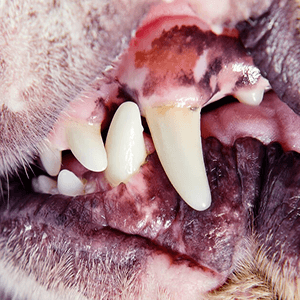Pet Dentistry: Non-anesthetic vs. Anesthetic
Why non-anesthetic dentistry, though increasingly popular, may cost you and your pet more in the long run.
Most people look at dentistry in terms of its cosmetic benefits only (clean, pearly white teeth, etc), but the truth is there are even stronger benefits to having healthy teeth and gums. In addition to pain and discomfort, poor dental health can lead to long term illnesses such as heart disease, kidney disease, systemic infections, and more due to a constant influx of bad bacteria into the blood stream from the infected mouth area.
Non-anesthetic dentistry may be cheaper and is certainly quicker, but it may also leave hidden and unresolved problems to get worse. Here is why non-anesthetic dentistry is not all it's cracked up to be:
- 1) - It may lead to undetected and unsolved dental problems that continue to get worse even after non-anesthetic dentals and even though the teeth are visibly clean on the outside. This is because non-anesthetic dentistry usually does not include X-Rays that allows a vet to see problems that are not visible with the naked eye. There could be a deep rooted abscess or bone thinning or bone fracture around the area supporting the teeth. On top of that, a pet's dental x-rays can only be done while under anesthesia. This is because of the X-ray sensor that must be positioned at various areas of the mouth when capturing X-ray images...a feat which is impossible with an awoken cat or dog. A pet under anesthesia will remain completely still (no unhealthy or stressful struggling) and the results are precise, jitter-free X-ray images with clear details of the extent of dental problems. This is safe for the pet and the doctor, but also protects the sensor from damage.
- 2) - Anesthesia and other pain management such as local blocks should be used to eliminate pain during any dental procedures. Without proper pain management, your pet will likely move around if he/she experiences pain during a procedure and that can lead to slip-ups, unchecked areas, and injuries. If your pet moves around, there is a good chance that it could lead to damage to the gum or worse the tooth enamel which cannot be repaired (leaving the sensitive areas of the teeth exposed). There can also be external injuries from your pet struggling such as neck, leg, or hip injuries, or even jaw fractures.
- 3) - In order to justify the lower cost, some non-anesthetic dentistry are done entirely by unsupervised technicians with limited expertise, which means they may have limited training in dentistry as compared to your Veterinarian.
- 4) - On the off chance that X-rays were attempted for non-anesthetic dentals, the bottom line is that, once detected, really bad dental disease cannot be properly treated for pain management unless anesthesia is used. In some cases dental surgery is needed for extractions, which can only be done under anesthesia.
To do a thorough and proper dental, your pet should be properly anesthetized and a full mouth x-ray should be taken. The risk of using anesthesia is typically very low when done correctly. Anesthesia should be customized to the age, weight, and health status of your pet, which is why only an experienced veterinarian should perform your your pet's dental procedure.
At Parkland Veterinary Hospital, WE DO NOT DO NON-ANESTHETIC DENTISTRY due to both the immediate risk of injury and the long term negative impact of your pet's deteriorating teeth and gums from that type of procedure.
Below are some of the problems that are undetectable without your pet being anesthetized:
- A) Tooth root abscess
- B) Tooth resorption
- C) Bone loss or fracture
- D) Tooth fractures
- E) Unerupted teeth
In my opinion and in the opinion of many veterinarians and board certified veterinary dental specialists, the risks of doing dentals without anesthesia far out ways the risk of using anesthesia (Preferred Anesthetic Dentistry) when proper pre-screening and procedural techniques are used by a trained professional, your veterinarian.
- Glenda Paredes, DVM at Parkland Veterinary Hospital -
